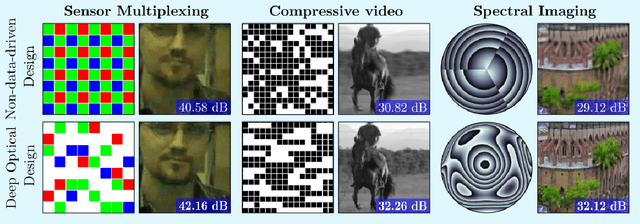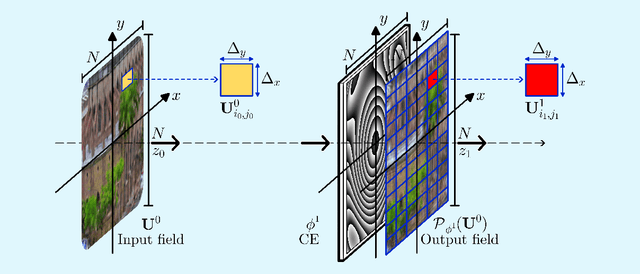Miguel Marquez
Deep Optical Coding Design in Computational Imaging
Jun 27, 2022



Abstract:Computational optical imaging (COI) systems leverage optical coding elements (CE) in their setups to encode a high-dimensional scene in a single or multiple snapshots and decode it by using computational algorithms. The performance of COI systems highly depends on the design of its main components: the CE pattern and the computational method used to perform a given task. Conventional approaches rely on random patterns or analytical designs to set the distribution of the CE. However, the available data and algorithm capabilities of deep neural networks (DNNs) have opened a new horizon in CE data-driven designs that jointly consider the optical encoder and computational decoder. Specifically, by modeling the COI measurements through a fully differentiable image formation model that considers the physics-based propagation of light and its interaction with the CEs, the parameters that define the CE and the computational decoder can be optimized in an end-to-end (E2E) manner. Moreover, by optimizing just CEs in the same framework, inference tasks can be performed from pure optics. This work surveys the recent advances on CE data-driven design and provides guidelines on how to parametrize different optical elements to include them in the E2E framework. Since the E2E framework can handle different inference applications by changing the loss function and the DNN, we present low-level tasks such as spectral imaging reconstruction or high-level tasks such as pose estimation with privacy preserving enhanced by using optimal task-based optical architectures. Finally, we illustrate classification and 3D object recognition applications performed at the speed of the light using all-optics DNN.
PrivHAR: Recognizing Human Actions From Privacy-preserving Lens
Jun 08, 2022



Abstract:The accelerated use of digital cameras prompts an increasing concern about privacy and security, particularly in applications such as action recognition. In this paper, we propose an optimizing framework to provide robust visual privacy protection along the human action recognition pipeline. Our framework parameterizes the camera lens to successfully degrade the quality of the videos to inhibit privacy attributes and protect against adversarial attacks while maintaining relevant features for activity recognition. We validate our approach with extensive simulations and hardware experiments.
 Add to Chrome
Add to Chrome Add to Firefox
Add to Firefox Add to Edge
Add to Edge